United Nations Trade and Development Report
Filter :
Sustainable Development Goals
Subject
Publication date

Trade and Development Report 2024
Rethinking Development in the Age of Discontent
The Trade and Development Report 2024 forecasts global growth in gross domestic product of 2.7 per cent for 2024 and 2025, marking three consecutive years below the 3 per cent pre-pandemic growth trend. Regionally, South Asia displays the most dynamic growth. The three major powers of the global economy – China, the United States of America and the European Union – are on decelerating or weakened growth trajectories. Despite the context of a turbocharged technological revolution, the much-needed acceleration in economic activity to achieve the Sustainable Development Goals remains elusive for many countries in the global South trapped by a confluence of high debt burdens, financial and resource outflows, weak investment and enforced austerity. Only 1 of the 46 least developed countries is currently meeting the promise of a 7 per cent annual growth target under the global Goals.
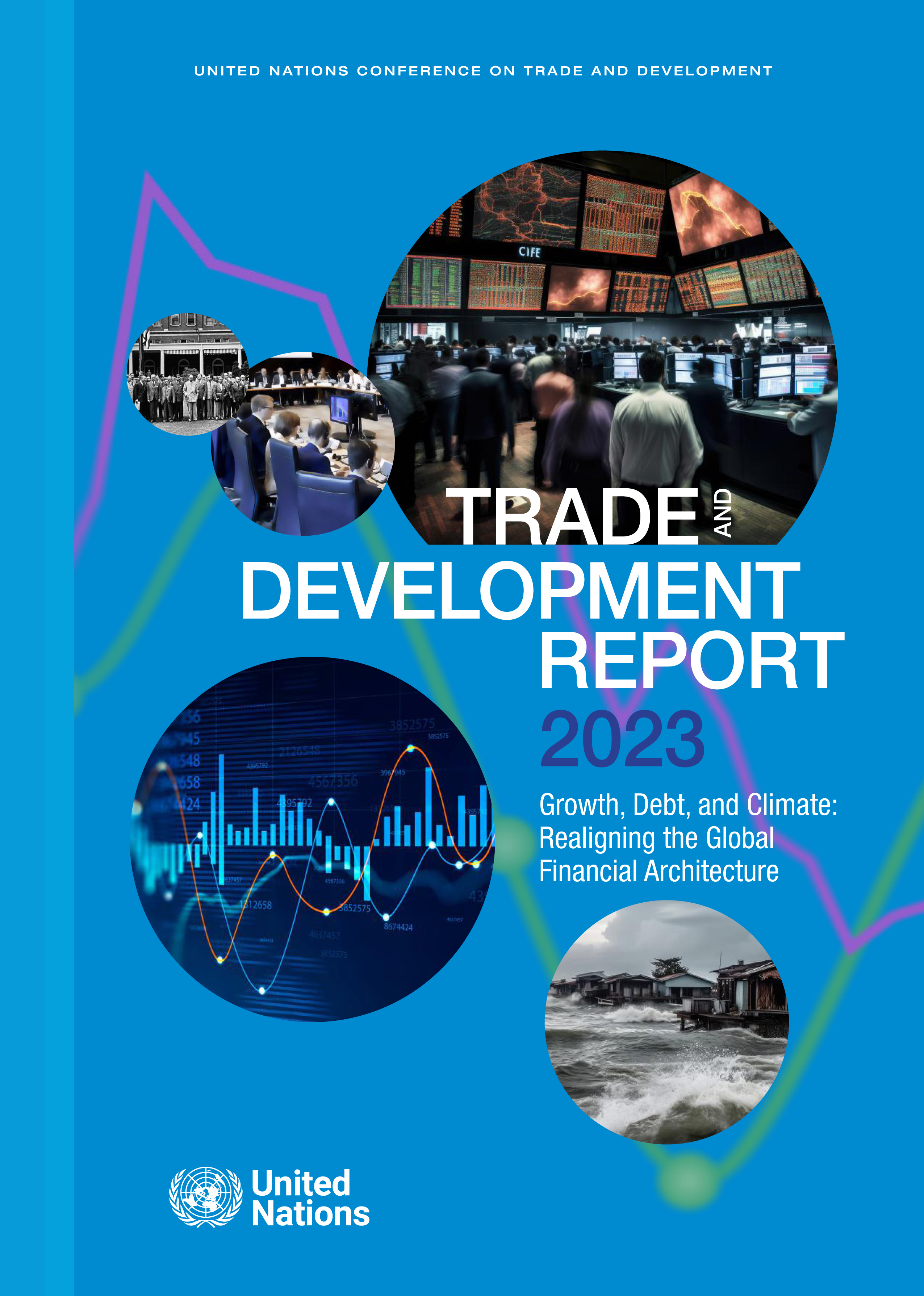
Trade and Development Report 2023
Growth, Debt, and Climate: Realigning the Global Financial Architecture
The Trade and Development Report 2023 analyses current economic trends and major policy issues of international concern and makes suggestions for addressing these issues at various levels. The report warns that the global economy is stalling, with growth slowing in most regions compared with last year and only a few countries bucking the trend. The global economy is at a crossroads, where divergent growth paths, widening inequalities, growing market concentration and mounting debt burdens cast shadows on the future. The prospect of meeting the Sustainable Development Goals (SDGs) by 2030 is fading as a combination of rising interest rates, weakening currencies and slowing export growth squeezes the fiscal space needed for governments to fight climate change and provide for their people. The report calls for a change in policy direction – including by leading central banks – and accompanying institutional reforms promised during the COVID-19 crisis to avert a lost decade. It urges global financial reforms, more pragmatic policies to tackle inflation, inequality and sovereign debt distress, and stronger oversight of key markets. The report proposes actions to get the global economy moving in the right direction by using a balanced policy mix of fiscal, monetary and supply-side measures to achieve financial stability, boost productive investment and create better jobs. Part I of the report launches on 4 October 2023 with part II expected in November.
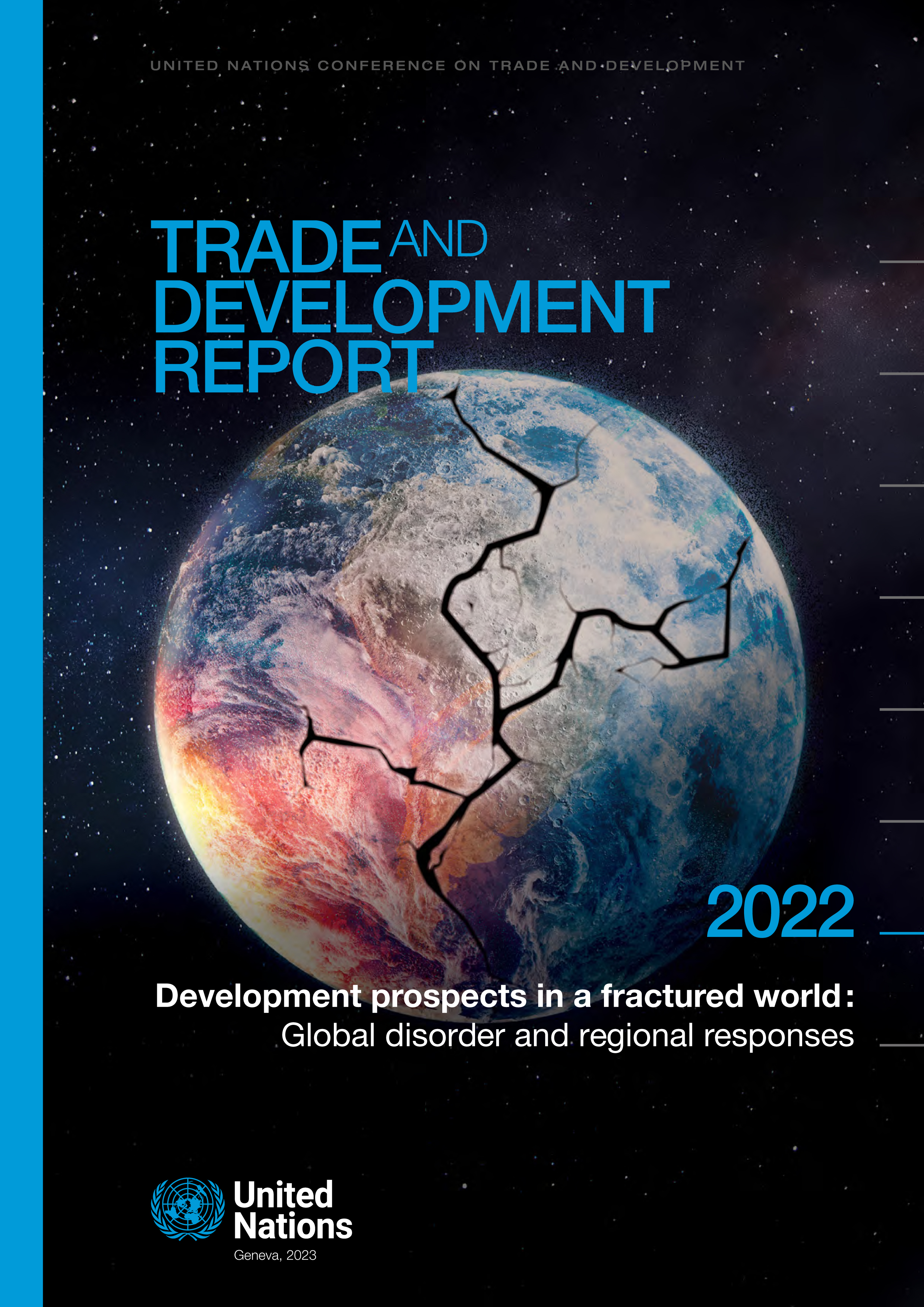
Trade and Development Report 2022
Development Prospects in a Fractured World: Global Disorder and Regional Responses
The Trade and Development Report 2022 analyses current economic trends and major policy issues of international concern, and makes suggestions for addressing these issues at various levels. This year report emphasizes that structural imbalances and inequalities in the global macroeconomic environment have grown since the global financial crisis and have intensified further with the Covid-19 pandemic. With less than a decade to meet the Agenda 2030, the Trade and Development Report 2022 finds that current policy trends could imperil the progress of developing countries towards inclusive and sustainable development. While improved policy coordination is needed at the multilateral level to better address the vulnerabilities facing developing countries, scaling up and strengthening regional arrangements can also help widen the opportunities from closer economic integration.
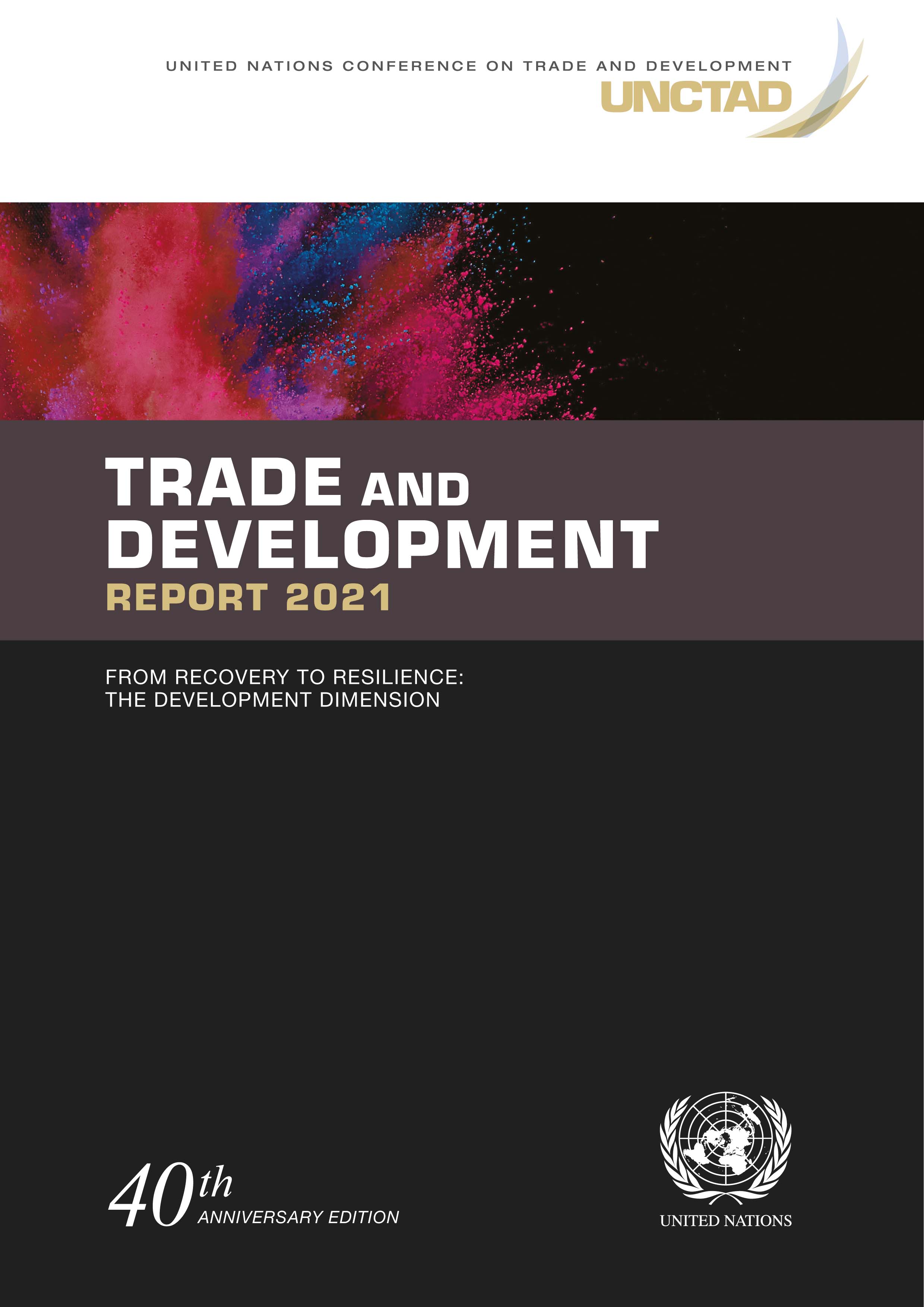
Trade and Development Report 2021
From Recovery to Resilience: The Development Dimension
This report analyses the state of the world economy, a year and half after the Covid-19 outbreak was declared a pandemic by the World Health Organization. The first part of the Report outlines key macro-financial aspects of the global economy, focusing, in particular, on the prospects for a growth recovery while analyzing possible threats from public and private debt, from inflationary spikes as well as from a return to the policies of the past. It pays particular attention to the situation of developing countries in the system of global finance, and discusses issues of debt sustainability. As this year marks its 40th anniversary, the Report also revisits the analyses provided in previous editions in response to shocks, setbacks, and crises that have hampered development during the era of hyperglobalization and underscores its abiding call for an inclusive global economic governance. The second part focuses on climate adaptation. It calls for a transformative approach to climate adaptation, with large-scale public investment programmes to adapt to future as well as current threats, and green industrial policies to drive growth and job creation. It also details reforms of the international financial system needed to get more climate adaptation funds flowing to developing countries.

Trade and Development Report 2020
From Global Pandemic to Prosperity for All - Avoiding Another Lost Decade
Drawing on the ideas and proposals presented in previous editions of the Report, this year’s Report analyses the economic impact of the Covid-19 (coronavirus) global pandemic and possible responses that could be both effective and inclusive. It examines different recovery scenarios and, in particular, highlights the danger of a lost decade, addresses immediate difficulties facing developing countries as they well as some of the underlying conditions that, if left unaddressed, will prevent a better recovery. It also discusses some of the institutional changes needed at the international level to bolster recovery and transition to a more socially caring and environmentally sustainable global economy – a transition that the world needed before the pandemic but has become ever more pressing.

Trade and Development Report 2019
Financing a Global Green New Deal
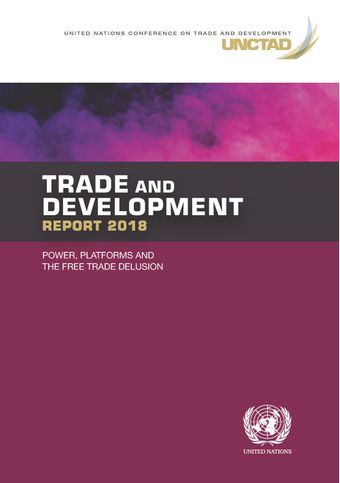
Trade and Development Report 2018
Power, Platforms and the Free Trade Delusion
This flagship publication examines different aspects of the nature and role of international trade in the era of hyperglobalization and considers related policy challenges that will need to be addressed if trade is to contribute to a more stable and inclusive global economic order. Research provides authoritative data and analysis on trade, investment, finance and technology. UNCTAD offers solutions to the major challenges facing developing countries, particularly the poorest and most vulnerable nations. Beyond tailored analysis and policy recommendations, UNCTAD research also generates global standards that govern responsible sovereign lending and borrowing, investment, entrepreneurship, competition and consumer protection and trade rules.
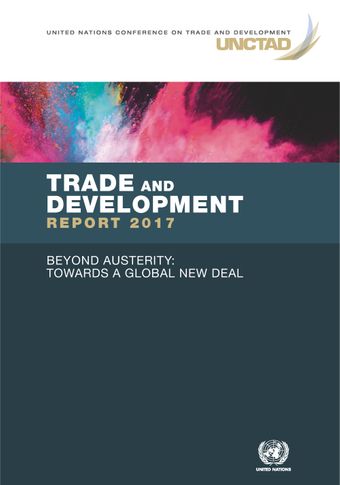
Trade and Development Report 2017
Beyond Austerity - Towards a Global New Deal
The Trade and Development Report (TDR), launched in 1981, is issued every year for the annual session of the Trade and Development Board. The Report analyses current economic trends and major policy issues of international concern, and makes suggestions for addressing these issues at various levels. This year’s Report focuses on the challenges for achieving inclusive growth in an era of austerity, hyper globalization and financial fragility. It includes chapters on robotics, gender and employment, finance and inequality, and the growing market power of non-financial corporations. It concludes by calling for Global New Deal, and the sorts of policy components it must include in light of the analyses provided.

Trade and Development Report 2016
Structural Transformation for Inclusive and Sustained Growth

Trade and Development Report 2015
Making the International Financial Architecture Work for Trade and Development
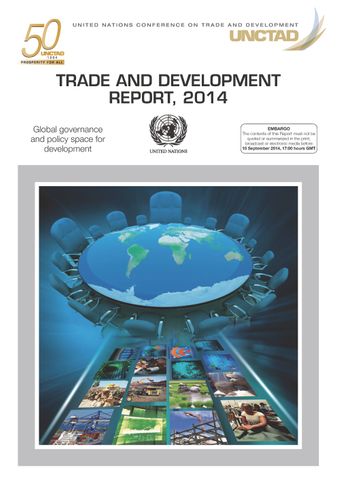
Trade and development report 2014
Global governance and policy space for development
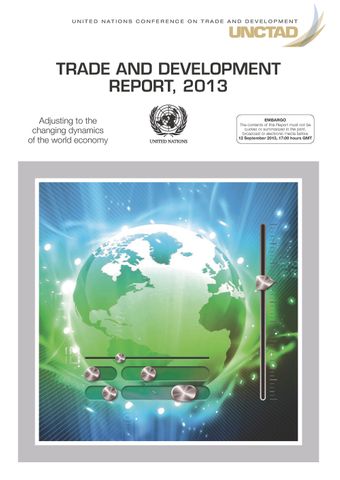
Trade and development report 2013
Adjusting to the changing dynamics of the world economy

Trade and Development Report 2012
Inclusive Policies for Sustainable Growth
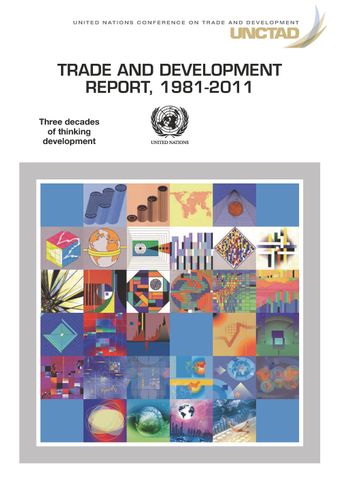
Trade and Development Report 1981-2011
Three Decades of Thinking Development
This publication identifies the key issues in the global economy and the design of development strategies addressed in the Trade and Development Report over the past three decades, tracing them through its various editions. It shows how ideas, opinions and proposals expressed in the Trade and Development Report, and the analytical approaches used, differed from those of “the mainstream” and their evolution in response to new challenges. This review revisits the concept of interdependence and explains the approach of the reports to macroeconomic and financial policies in both developed and developing countries. It also summarizes development policy failures and successes over the years.
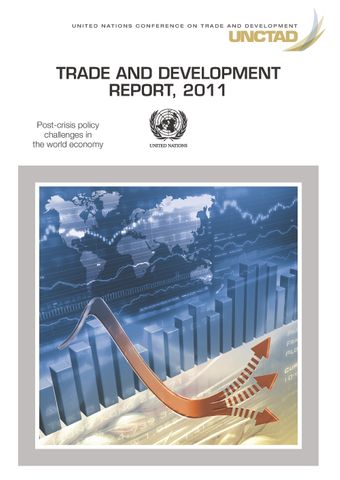
Trade and Development Report 2011
Post-crisis Policy Challenges in the World Economy
Reforms of financial regulations are progressing slowly and only at the national level, monetary system reform is limited. After an interlude that some considered as a return to Keynesianism, the orientation of macroeconomic policy, especially fiscal policy, is back to business as usual. This will hinder a sustained recovery of the world economy and open the door for new financial crises. Thus, the rethinking of policies and reshaping the financial and monetary system remain an urgent task. This publication makes concrete proposals on how, and in which priority areas, to advance with strengthening regulation of the financial sector and commodity markets, reform of the international monetary system, and the reorientation of fiscal policy.

Trade and Development Report 2010
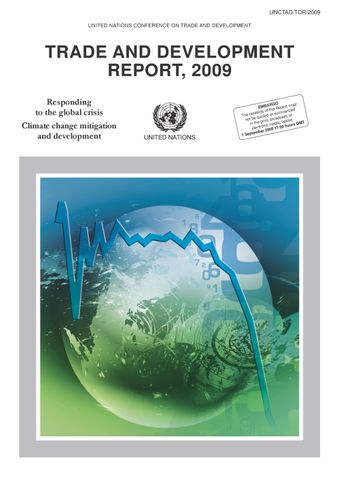
Trade and Development Report 2009

Trade and Development Report 2008
Commodity Prices, Capital Flows and the Financing of Investment
The Trade and Development Report 2008, subtitled Commodity Prices, Capital Flows and the Financing of Investment” highlights the paradox that the “capital poor” developing world is exporting capital to the “capital rich” developed countries. The Report suggests shifting the focus in financial policies from households putting more money aside and imports of foreign savings, to the reinvestment of profits and credit creation through the domestic banking system.

Trade and Development Report 2007
Regional Cooperation for Development
The current edition of the Report anticipates a fifth consecutive year of overall output growth and continued strong demand for primary commodities contributing to an overall increase in per capita gross domestic product in developing countries. The main risk to this positive scenario, the Report warns, is that a major recession in the United States could sharply curtail exports from China and India, which are setting the pace for this growth. The report says regional cooperation can help reduce the vulnerability of developing nations to current account imbalances such as that of the US, and also reduce their vulnerability to major shifts in exchange rates caused by speculative capital flows.
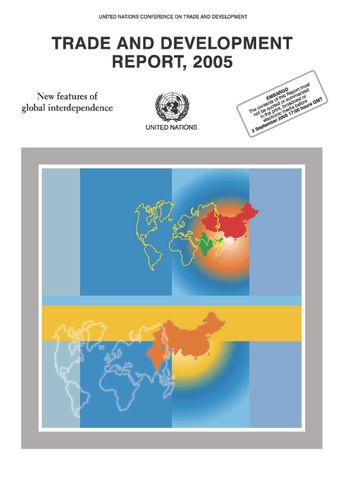
Trade and Development Report 2005
New Features of Global Interdependence
The world economy is still expanding, but there are serious risks of a setback. Several populous Asian countries, in particular China and India, have emerged as new engines of economic growth. Thanks to their vigorous expansion and their appetite for natural resources, many of their developing-country trade partners have reaped windfall profits from rising commodity prices and from surging demand for intermediate products. Some dark clouds are looming over this rather rosy horizon. Oil prices are historically high and place a huge burden on many developing countries. And there has been no multilateral action that might gently defuse global current-account imbalances. The Trade and Development Report recommends that international initiatives to alleviate poverty and reach the MDGs should not ignore the importance of a smooth unwinding of global economic imbalances that will allow the Asian Miracle to continue, along with its positive repercussions for other less wealthy countries.
